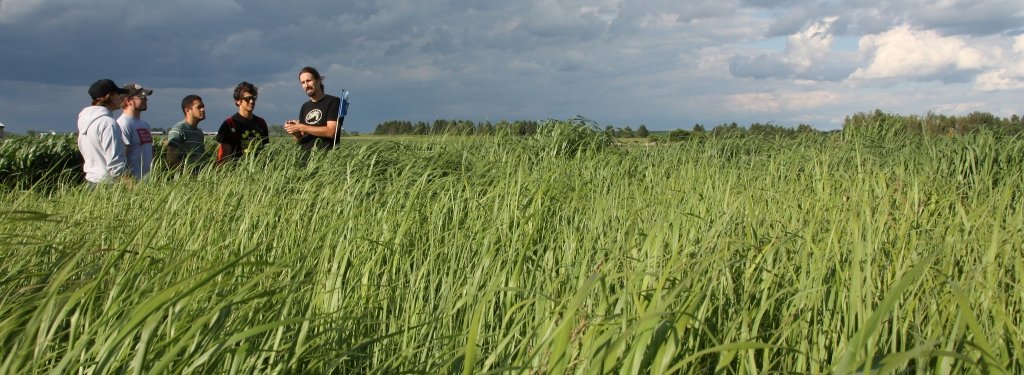Tree Genome Research Could Lead to Better Biofuel Production, Combat Global Warming
Wood from a common tree may one day play a major role in filling American gas tanks, according to scientists whose research on the fast-growing poplar tree is featured on the cover of Friday's (Sept. 15, 2006) edition of the journal Science.
The article, coauthored in part by three faculty members in the School of Forest Resources and Environmental Science, highlights the analysis of the first complete DNA sequence of a tree, the black cottonwood or Populus trichocarpa. It lays groundwork for the potential development of trees that could serve as the ideal "feedstock" for a new generation of biofuels such as cellulosic ethanol.
The research is the result of a four-year effort, led by the U.S. Department of Energy's Joint Genome Institute and Oak Ridge National Laboratory, uniting the efforts of 34 institutions from around the world, including Michigan Tech. The lead author is ORNL and DOE JGI researcher Gerald A. Tuskan.
The effort has been a mountaintop experience for the Michigan Tech team. "We've been doing this kind of research at Michigan Tech for 20 years, and we've made a number of groundbreaking discoveries," said Professor Chung-Jui Tsai, director of the Biotechnology Research Center and one of the three Michigan Tech coauthors of the Science article, along with Assistant Professor Victor Busov and Associate Professor Chandrashekhar Joshi. "But this is a real milestone for the entire forest research community."
The research opens the door to solving some of the earth's most pressing ecological problems. "By understanding the tree genome, we could plant trees that lower greenhouse gases," said Joshi.
As evidence of global warming mounts, scientists are studying trees as an alternative energy source. Like fossil fuels, they release the greenhouse gas carbon dioxide when they burn. However, unlike oil and gas, they absorb it from the atmosphere as they grow, essentially mopping up after themselves, through a process known as carbon sequestration.
"This opens up opportunities for environmentalists and biotechnologists to work together," Busov said. "Eventually, we might be able to use that knowledge to reduce greenhouse gases and improve soil fertility, as well as provide an enhanced source of biofuels."
Poplar's extraordinarily rapid growth and its relatively compact genome size of 480 million nucleotide units, 40 times smaller than the genome of pine, are among the many features that led researchers to target poplar as a model crop for biofuels production.
"Under optimal conditions, poplars can add a dozen feet of growth each year and reach maturity in as few as four years, permitting selective breeding for large-scale sustainable plantation forestry," said Sam Foster of the U.S. Forest Service. "This rapid growth coupled with conversion of the lignocellulosic portion of the plant to ethanol has the potential to provide a renewable energy resource along with a reduction of greenhouse gases."
The research team identified 93 genes associated with the production of cellulose, hemicellulose and lignin, the building blocks of plant cell walls. The biopolymers cellulose and hemicellulose constitute the most abundant organic materials on earth, which by enzymatic action can be broken down into sugars that in turn can be fermented into alcohol and distilled to yield fuel-quality ethanol and other liquid fuels.
Poplar is the most complex genome to be sequenced and assembled by a single public sequencing facility and only the third plant to date to have its genome completely sequenced and published. The first, back in 2000, was the tiny weed Arabidopsis thaliana an important model for plant genetics. Rice was the second, two years ago.
Populus trichocarpa is one of the tallest broadleaf hardwood trees in the western U.S., native to the Pacific coast from San Diego to Alaska. The sequenced DNA was isolated from a specimen collected along the banks of the Nisqually River in Washington state.
Among the major discoveries yielded from the poplar project is the identification of over 45,000 protein-coding genes, more than any other organism sequenced to date, approximately twice as many as present in the human genome (which has a genome six times larger than the poplar's).
The poplar project supports a broader DOE drive to accelerate research into biofuels production under the Bush Administration's Advanced Energy Initiative. Scientists envision a future where vast poplar farms in regions such as the Upper Midwest, the Pacific Northwest and portions of the southeastern U.S. could provide a steady supply of tree biomass rich in cellulose that can be transformed by specialized biorefineries into fuels like ethanol. Other regions of the country might specialize in different "energy crops" suited to their particular climate and soil conditions, including such plants as switchgrass and willow. In addition, a large quantity of biofuels might be produced from agricultural and forestry waste.
Now that the genes have been identified, the consortium of scientists is now working on the next phase of the project: deciphering the role played by each gene.
"There are secrets to life embedded in this genome that we don't know anything about," Busov said. For instance, trees live longer and grow larger than any other living thing, and the mechanisms controling that are encoded in their DNA.
"Our next step is to create knowledge from this information," said Joshi. "And the final step will be to use that knowledge with wisdom, to benefit every organism on earth."
Michigan Technological University is an R1 public research university founded in 1885 in Houghton, and is home to nearly 7,500 students from more than 60 countries around the world. Consistently ranked among the best universities in the country for return on investment, Michigan's flagship technological university offers more than 185 undergraduate and graduate degree programs in science and technology, engineering, computing, forestry, business, health professions, humanities, mathematics, social sciences, and the arts. The rural campus is situated just miles from Lake Superior in Michigan's Upper Peninsula, offering year-round opportunities for outdoor adventure.




Comments